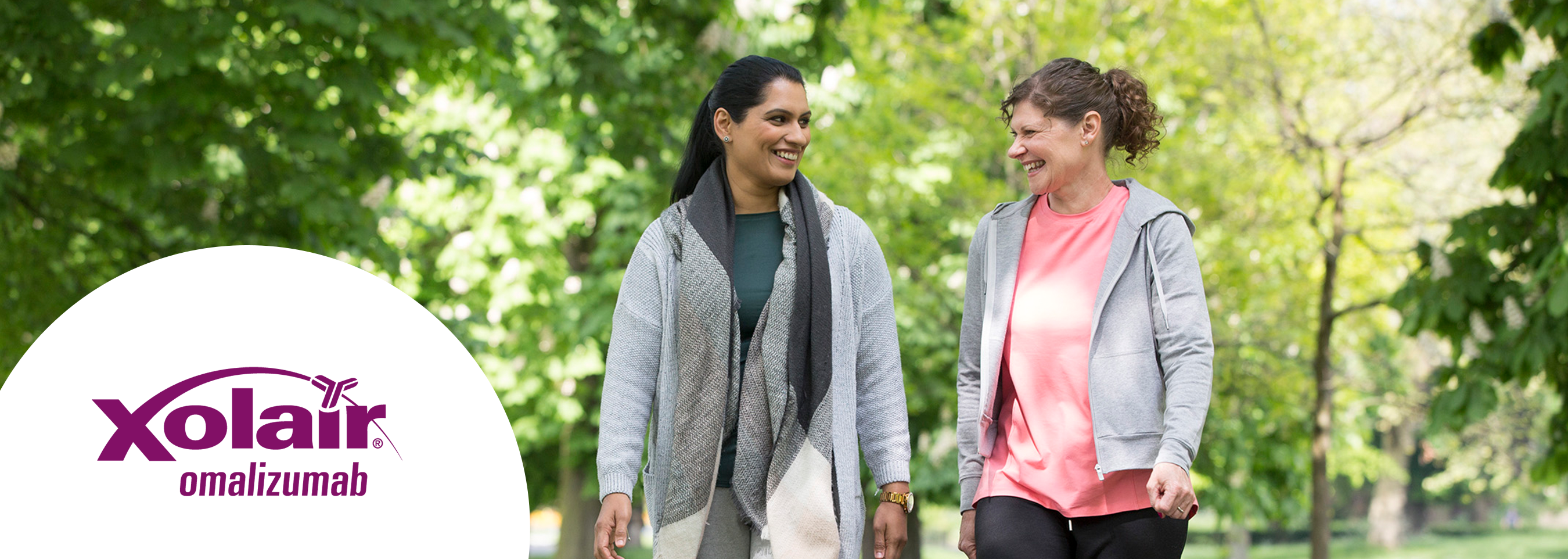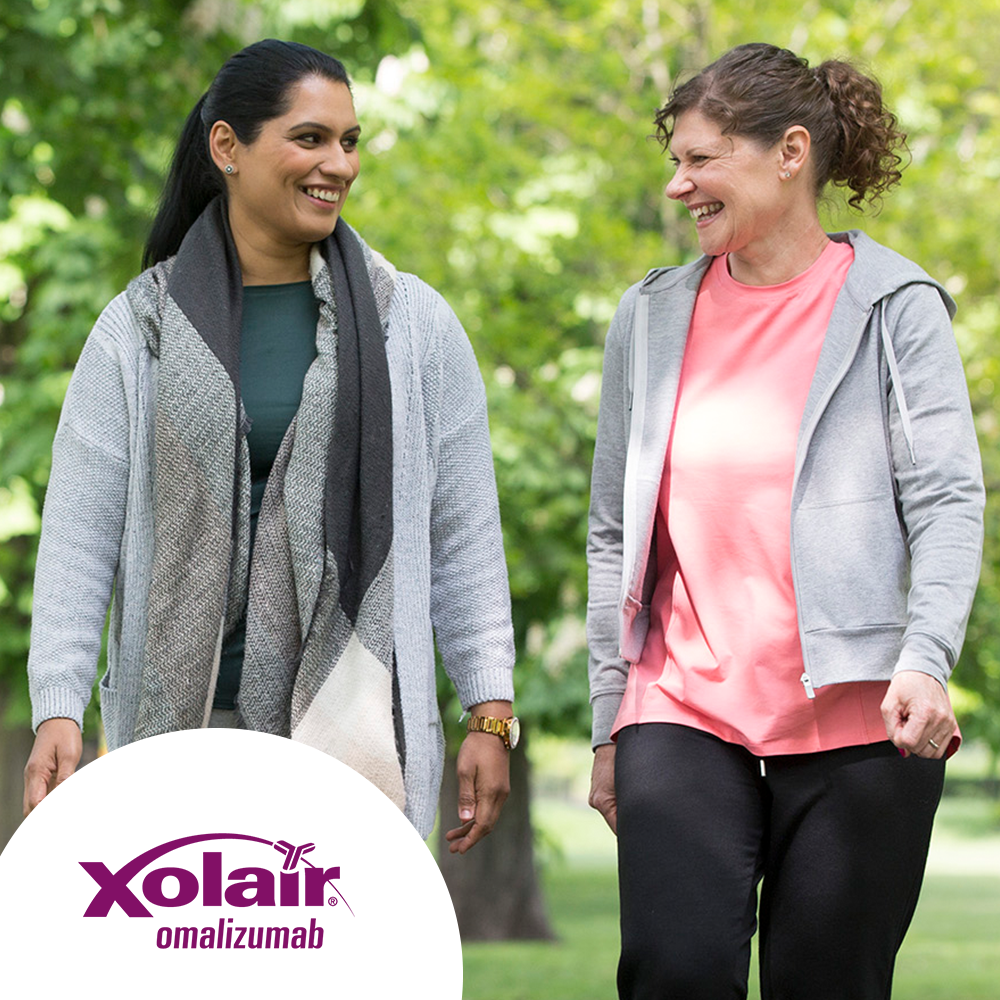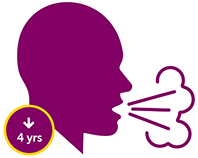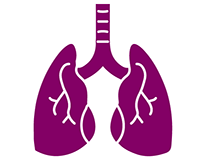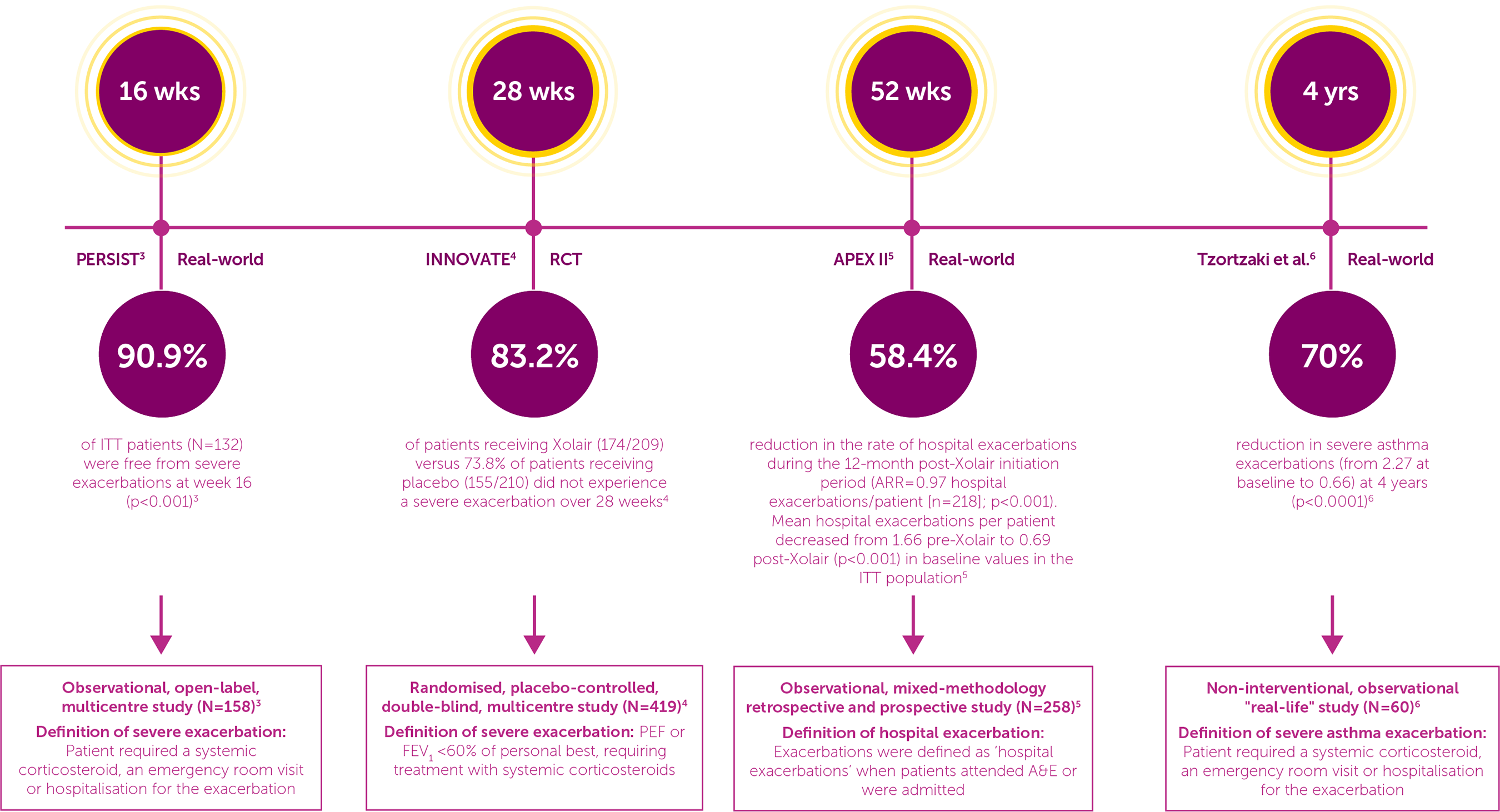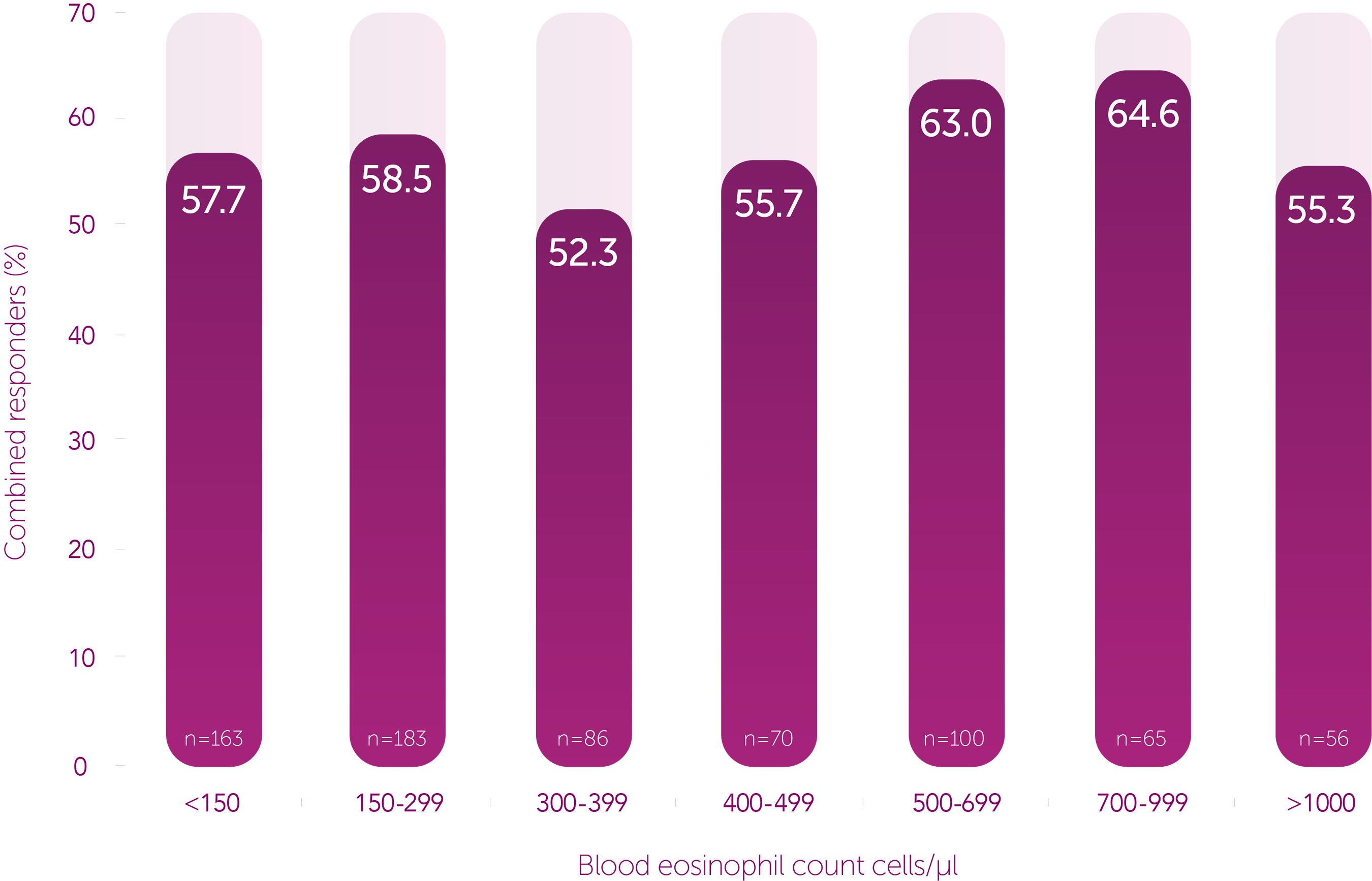Xolair® (omalizumab) resources
Downloadable materials to support the use of Xolair in day-to-day practice.
This page is intended for UK healthcare professionals and other relevant decision makers only. If you are a member of the public, please click here.
This portal is funded and owned by Novartis Pharmaceuticals UK Ltd and includes content approved by Novartis.
Adverse events reporting information can be found in the footer of this page.
Indications in severe allergic asthma (SAA):1
Xolair is indicated in adults, adolescents and children (6 to <12 years of age).
Xolair treatment should only be considered for patients with convincing immunoglobulin E (IgE) mediated asthma.
Adults and adolescents (12 years of age and older)
Xolair is indicated as add-on therapy to improve asthma control in patients with severe persistent allergic asthma who have a positive skin test or in vitro reactivity to a perennial aeroallergen and who have reduced lung function (FEV1 <80%) as well as frequent daytime symptoms or night-time awakenings and who have had multiple documented severe asthma exacerbations despite daily high-dose inhaled corticosteroids, plus a long-acting inhaled beta2-agonist.
Children (6 to <12 years of age)
Xolair is indicated as add-on therapy to improve asthma control in patients with severe persistent allergic asthma who have a positive skin test or in vitro reactivity to a perennial aeroallergen and frequent daytime symptoms or night-time awakenings and who have had multiple documented severe asthma exacerbations despite daily high-dose inhaled corticosteroids, plus a long-acting inhaled beta2-agonist.
Please refer to the Xolair Summary of Product Characteristics (SmPC) for the full therapeutic indications.1
In a systematic review of 42 real-world studies:2
Xolair was observed to reduce the frequency of exacerbations vs baseline up to and beyond 4 years2
Xolair was observed to reduce the number of exacerbations per year by 71% vs baseline at ≥36 months (n=95). At baseline, the weighted mean number of exacerbations per patients in the preceding year was 4.0 (n=25 studies)2
Data are from studies with different designs and cannot be directly compared.
Rate of clinically significant asthma exacerbations (defined as a worsening of asthma symptoms requiring treatment with systemic corticosteroids) during the 28-week double-blind treatment phase:
Post-hoc primary ITT analysis (with adjustment for baseline exacerbation history): 0.68 for Xolair versus 0.91 for placebo (p=0.042)
Rate ratio without adjustment for baseline exacerbation history was not statistically significant (0.806 [95% CI: 0.552–0.998]; p=0.153).
Xolair is intended for long-term use; clinical trials have demonstrated that it takes at least 12–16 weeks for Xolair treatment to show effectiveness.1
In the INNOVATE RCT (N=419):4
60.5% of patients treated with Xolair (n=209) had a good or excellent investigators’ global evaluation of treatment effectiveness (GETE) rating vs 42.8% of patients who received placebo (n=210) at Week 28 (p<0.001)4
64.3% of patients treated with Xolair (n=209) had a good or excellent patients’ global evaluation of treatment effectiveness rating vs 43.3% of patients who received placebo (n=210) at Week 28 (p<0.001)4
A retrospective, real-world study of 872 SAA patients aged ≥6 years (STELLAIR) demonstrated:7
Proportion of combined responders in ‘low’ and ‘high’ blood eosinophil groups:7
Low (eosinophil count <300 cells/μl): 58.1% (95% CI: 52.7–63.4%) (n=346)
High (eosinophil count ≥300 cells/μl): 58.4% (95% CI: 53.2–63.4%) (n=377)
Adapted from Humbert M, et al. 2018.7
In rare cases, patients on therapy with anti-asthma medicinal products, including Xolair, may present or develop systemic eosinophilia and vasculitis. These events are commonly associated with the reduction of oral corticosteroid therapy. In these patients, physicians should be alert to the development of marked eosinophilia, vasculitic rash, worsening pulmonary symptoms, paranasal sinus abnormalities, cardiac complications, and/or neuropathy. Discontinuation of omalizumab should be considered in all severe cases with the above-mentioned immune system disorders.1
In a retrospective, real-world study of 872 SAA patients aged ≥6 years (STELLAIR):7
For patients requiring OCS maintenance (n=195), within a year of Xolair initiation:7
For information on Xolair’s safety profile
A prospective, open-label, observational, multicentre 52-week study in 158 patients (aged ≥12 years) with severe persistent allergic asthma despite treatment with an ICS and a LABA.
Primary objectives:
Describe the patients who, in the treating physician’s best clinical judgement, were being treated with Xolair
Determine the 16- and 52-week effectiveness of Xolair as an add-on therapy by measuring the proportion of patients:
improving in 2005 GINA classification
with good/excellent GETE rating
achieving ≥0.5 point improvement in total AQLQ score
severe exacerbation-free (severe exacerbation defined as exacerbation during which the patient required a systemic corticosteroid, or emergency room visit or hospitalisation for the exacerbation
improving in EQ-5D utility (52 weeks only)
Describe the treatment patterns involving add-on Xolair treatment
Describe the safety and tolerability of treatment with Xolair when used in a pragmatic trial
A randomised, multicentre, placebo-controlled, double-blind, parallel-group study in 419 patients (aged 12–75 years) with severe persistent allergic asthma who were inadequately controlled despite treatment with a high-dose ICS plus LABA, and additional controller medication if required.
The primary efficacy variable analysis included a post-hoc adjustment for baseline exacerbation history. After adjustment for the primary ITT population, the clinically significant asthma exacerbation rate showed a statistically significant between-group difference (0.68 with Xolair vs 0.91 with placebo; p=0.042).
Primary endpoint:
Rate of clinically significant asthma exacerbations (defined as a worsening of asthma symptoms requiring treatment with systemic corticosteroids) during the 28-week double-blind treatment phase
Secondary endpoints included:
Severe exacerbation rate (severe exacerbation defined as PEF or FEV1 <60% of personal best, requiring treatment with systemic corticosteroids)
Rate of hospitalisation, emergency room visits, and unscheduled doctor’s visits for exacerbations
Symptoms, morning PEF, rescue medication use and FEV1
Quality of life at weeks 0, 12 and 28 of the treatment phase (assessed using AQLQ)
Treatment effectiveness at treatment end
Observational, retrospective, mixed-methodology study assessing the real-life effectiveness of Xolair in 258 patients (aged ≥16 years) with severe persistent allergic asthma.
Primary endpoint:
Change in mean daily dose of OCS prescribed per patient between the 12-month pre-Xolair and post-Xolair initiation periods
Secondary endpoints included:
Proportion of patients stopping and/or reducing OCS by ≥20%
Exacerbation rate (exacerbations requiring either hospitalisation or increase in OCS dose ≥10 mg at any point for at least 3 days)
Hospital resource use
Lung function
Patient-reported outcomes
Four-year non-interventional, retrospective, observational, multicentre study in 60 patients (aged ≥12 years) with poorly controlled severe persistent allergic asthma despite treatment with a high-dose ICS and a LABA according to the GINA guidelines.
Endpoints:
Effectiveness of Xolair, at 4 months, 1 year and 4 years, as add-on therapy in relation to:
Lung function (FEV1 and FVC)
Number of severe exacerbations (patient required a systemic corticosteroid, required an ER visit or was hospitalised for the exacerbation)
Level of asthma control
Daily dose of ICS
A multicentre, non-interventional, retrospective, observational study using data from medicinal records of of 872 patients with SAA treated with Xolair.
Primary endpoint:
Response to Xolair at T4–6 compared with T–12 using GETE, ≥40% reduction in annual exacerbation rate and a combined response of both
Response was analysed according to blood eosinophil count (cells/µL) measured in the year prior to Xolair initiation.
A&E, accident and emergency; AQLQ, asthma quality of life questionnaire; ARR; absolute rate reduction; EQ-5D, EuroQol 5-Dimensions; ER, emergency room; GETE, global evaluation of treatment effectiveness; ICS, inhaled corticosteroid; IgE, immunoglobulin E; ITT, intent-to-treat; FEV1, forced expiratory volume in 1 second; FVC, forced expiratory volume; GINA, Global Initiative for Asthma; LABA, long-acting beta2-agonist; OCS, oral corticosteroid; PEF, peak expiratory flow; RCT, randomised controlled trial; SAA, severe allergic asthma; SmPC, summary of product characteristics.
References
Xolair® (omalizumab) Summary of Product Characteristics.
MacDonald KM, et al. Expert Rev Clin Immunol 2019;15(5):553–569.
Brusselle G, et al. Respir Med 2009;103(11):1633–1642.
Humbert M, et al. Allergy 2005;60(3):309–316.
Niven RM, et al. BMJ Open 2016;6:e011857.
Tzortzaki EG, et al. Pulm Pharmacol Ther 2012;25(1):77–82.
Humbert M, et al. Eur Respir J 2018;51(5):1702523.
UK | May 2025 | FA-11359950-1
Adverse events should be reported. Reporting forms and information can be found at www.mhra.gov.uk/yellowcard. Adverse events should also be reported to Novartis online through the pharmacovigilance intake (PVI) tool at www.novartis.com/report, or alternatively email [email protected] or call 01276 698370.
